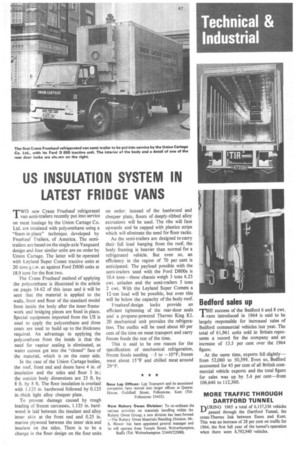US INSULATION SYSTEM IN LATEST FRIDGE VANS
Page 49

If you've noticed an error in this article please click here to report it so we can fix it.
TWO new Crane Fruehauf refrigerated van new recently put into service
on meat haulage by the Union Cartage Co. Ltd. are inSulated with polyurethane using a "foam--in-place" technique, developed by Fruehauf Trailers, of America. The semitrailers are based on the single-axle Vanguard design and four similar units are on order by Union Cartage. The latter will be operated with Leyland Super Comet tractive units at 20 tons g.t.w. as against Ford D800 units at 18.9 tons for the first two.
The Crane Fruehauf method of applying the polyurethane is illustrated in the article on pages 54-62 of this issue and it will be seen that the material is applied to the walls, front and floor of the standard model from inside the body after the inner framework and bridging pieces are fixed in place. Special equipment imported from the US is used to apply the polyurethane and three coats are used to build up to the thickness required. An advantage in applying the polyurethane from the inside is that the need for vapOur sealing is eliminated, as water cannot get into the "closed" face of the material, which is on the outer side.
In the case of the Union Cartage bodies, the roof, front end and doors have 4 in. of insulation and the sides and floor 3 in.; the outside body dimensions are 25 fl. by 8 ft. by 8 ft. The floor insulation is overlaid with 1.125 in. hardwood followed by 0.125 in.-thick light alloy chequer plate.
To prevent damage caused by rough loading of frozen carcasses, 1.125 in. hardwood is laid between the insulant and alloy inner skin at the front end and 0.25 in. marine plywood between the inner skin and insulant on the sides. There is to be a change in the floor design on the four units on order: instead of the hardwood and chequer plate, floors of deeply-ribbed alloy extrusions will be used. The ribs will face upwards and be capped with plastics strips which will eliminate the need for floor racks.
As the semi-trailers are designed to carry their full load hanging from the roof, the body framing is heavier than normal for a refrigerated vehicle. But even so, an efficiency in the region of 70 per cent is anticipated. The payload possible with the semi-trailers used with the Ford D800s is 10.4 tons—these chassis weigh 3 tons 6.25 cwt. unladen and the semi-trailers 5 tons 2 cwt. With the Leyland Super Comets a 12-ton load will be possible, but even this will be below the capacity of the body roof.
Fruehauf-design locks provide an efficient tightening of the rear-door seals and a propane-powered Thermo King KL 20 mechanical unit provides the refrigeration. The outfits will be used about 60 per cent of the time on meat transport and carry frozen foods the rest of the time.
This is said to be one reason for the specification of mechanical refrigeration, frozen foods needing —5 to —10°F, frozen meat about 15°F and chilled meat around 29°F.
New Lep Offices: Lep Transport and its associated companies have moved into larger offices at Queens House, Guildhall Street, Folkestone. Kent (Tel: Folkestone 55455).
New Rubery Owen Division: To co-ordinate the various activities on materials handling within the Rubery Owen Group, a new division has been formed —The Rubery Owen Materials Handling Division. Mr. S. Blower has been appointed general manager and he will operate from Temple Street, Wolverhampton,
Staffs (Tel: Wolverhampton 25449/22900).
















































































































































